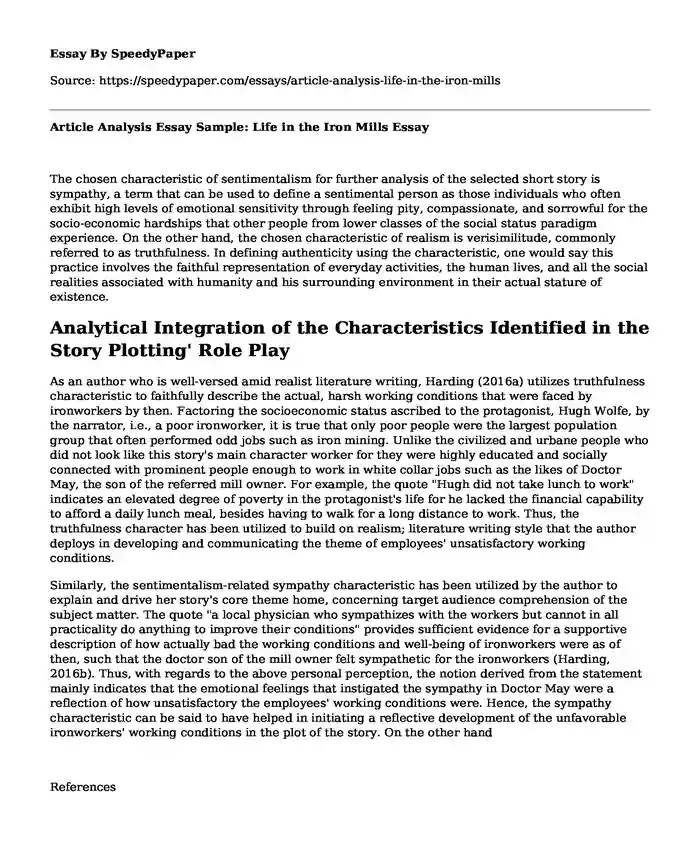
| Type of paper: | Essay |
| Categories: | Psychology Personality |
| Pages: | 2 |
| Wordcount: | 481 words |
The chosen characteristic of sentimentalism for further analysis of the selected short story is sympathy, a term that can be used to define a sentimental person as those individuals who often exhibit high levels of emotional sensitivity through feeling pity, compassionate, and sorrowful for the socio-economic hardships that other people from lower classes of the social status paradigm experience. On the other hand, the chosen characteristic of realism is verisimilitude, commonly referred to as truthfulness. In defining authenticity using the characteristic, one would say this practice involves the faithful representation of everyday activities, the human lives, and all the social realities associated with humanity and his surrounding environment in their actual stature of existence.
Analytical Integration of the Characteristics Identified in the Story Plotting' Role Play
As an author who is well-versed amid realist literature writing, Harding (2016a) utilizes truthfulness characteristic to faithfully describe the actual, harsh working conditions that were faced by ironworkers by then. Factoring the socioeconomic status ascribed to the protagonist, Hugh Wolfe, by the narrator, i.e., a poor ironworker, it is true that only poor people were the largest population group that often performed odd jobs such as iron mining. Unlike the civilized and urbane people who did not look like this story's main character worker for they were highly educated and socially connected with prominent people enough to work in white collar jobs such as the likes of Doctor May, the son of the referred mill owner. For example, the quote "Hugh did not take lunch to work" indicates an elevated degree of poverty in the protagonist's life for he lacked the financial capability to afford a daily lunch meal, besides having to walk for a long distance to work. Thus, the truthfulness character has been utilized to build on realism; literature writing style that the author deploys in developing and communicating the theme of employees' unsatisfactory working conditions.
Similarly, the sentimentalism-related sympathy characteristic has been utilized by the author to explain and drive her story's core theme home, concerning target audience comprehension of the subject matter. The quote "a local physician who sympathizes with the workers but cannot in all practicality do anything to improve their conditions" provides sufficient evidence for a supportive description of how actually bad the working conditions and well-being of ironworkers were as of then, such that the doctor son of the mill owner felt sympathetic for the ironworkers (Harding, 2016b). Thus, with regards to the above personal perception, the notion derived from the statement mainly indicates that the emotional feelings that instigated the sympathy in Doctor May were a reflection of how unsatisfactory the employees' working conditions were. Hence, the sympathy characteristic can be said to have helped in initiating a reflective development of the unfavorable ironworkers' working conditions in the plot of the story. On the other hand
References
Harding, R. (2016). LIFE IN THE IRON-MILLS. LULU COM.
Cite this page
Article Analysis Essay Sample: Life in the Iron Mills. (2022, Jul 27). Retrieved from https://speedypaper.com/essays/article-analysis-life-in-the-iron-mills
Request Removal
If you are the original author of this essay and no longer wish to have it published on the SpeedyPaper website, please click below to request its removal:
- Pike River Mine Disaster in This Free Essay
- Free Essay on Gerontology and Physical Health
- Essay Example about Acid Precipitation (Acid Rain)
- Exporting and Economic / Political Systems, Essay Example
- Free Essay: Experiences with Race and Assimilation
- Paper Example. People and the Process of Change
- Essay Sample on Reason for Restaurants to Change Their Menu
Popular categories




